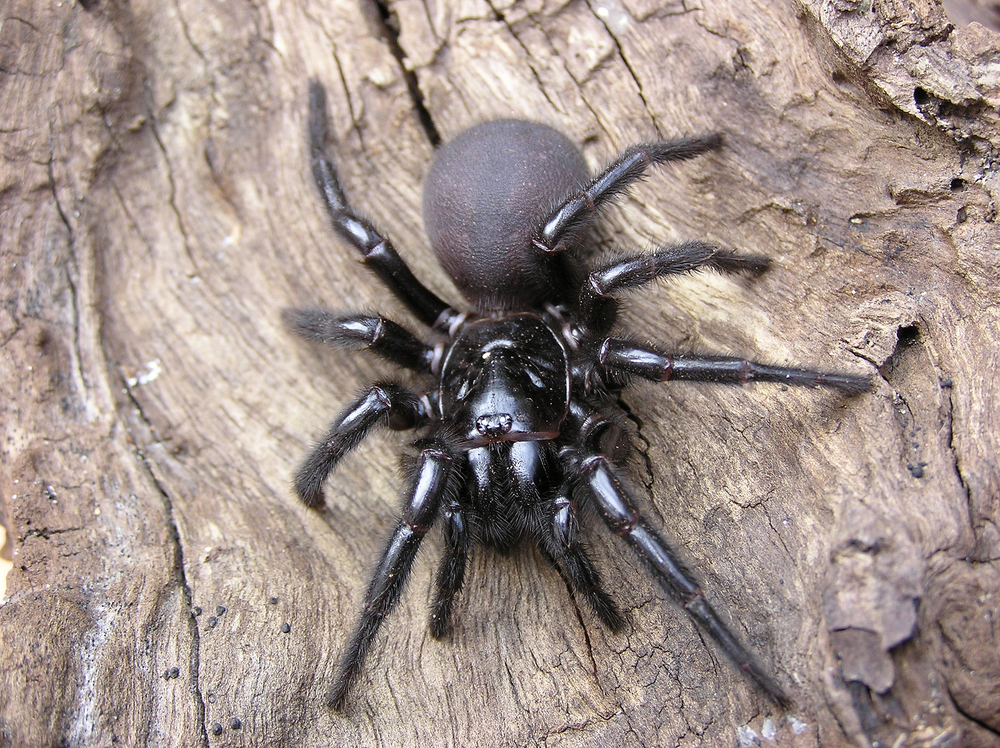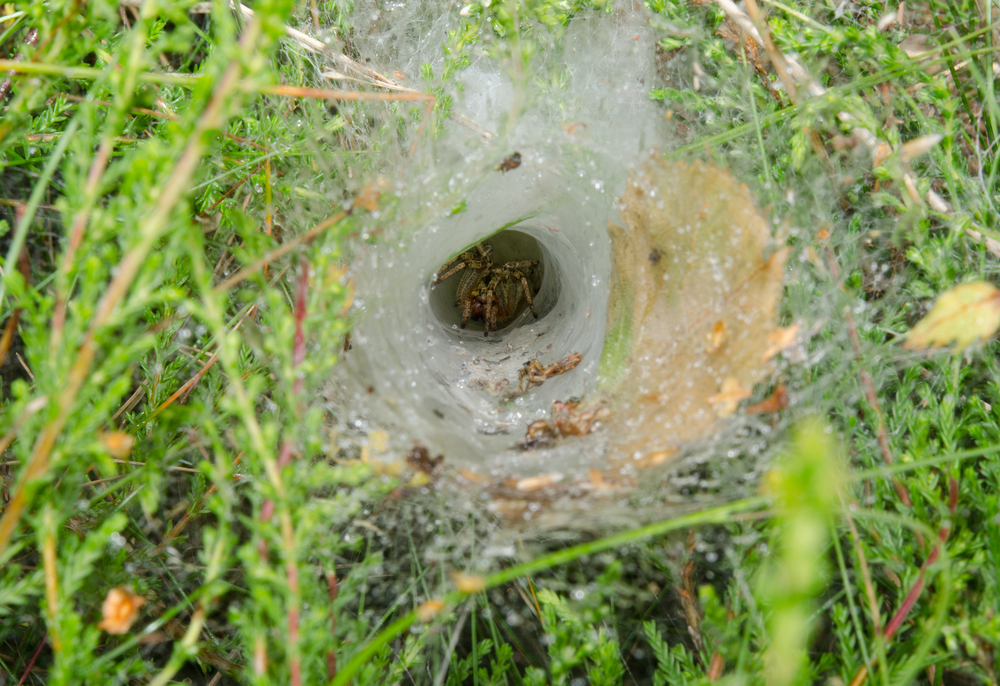Funnel-Web Spiders: Families, Bites & Other Facts

Funnel-web spiders are spiders that build funnel-shaped webs, which they use as burrows or to trap prey. Three distinct spider families are known popularly as funnel-web spiders, but they are all quite different. Some species are among the most deadly spiders in the world, while others are not harmful to humans.
These spiders get their name because, generally, their webs have a flat surface for capturing prey and a small funnel-like tube leading to a silken burrow in which the spider hides, according to the University of California's Integrated Pest Management Program (IPM). The spider waits in the funnel for prey to fall onto the horizontal web, and then it rushes out, grabs the prey, and takes it back to the funnel to consume.
Taxonomy/classification
According to the Integrated Taxonomic Information System (ITIS), the taxonomy of spiders is:
- Kingdom: Animalia
- Subkingdom: Bilateria
- Infrakingdom: Protostomia
- Superphylum: Ecdysozoa
- Phylum: Arthropoda
- Subphylum: Chelicerata
- Class: Arachnida
- Order: Araneae
- Families: There are more than 100 families of spiders. Three are known popularly as funnel-web spiders: Agelenidae, Dipluridae and Hexathelidae.
Agelenidae: Non-dangerous funnel spiders
Agelenidae spiders, also called funnel weavers, live throughout the world. According to the Encyclopedia of Life(EOL), there are nearly 1,200 species of agelenids worldwide; about 100 of them are found in North America. “This family includes the grass spiders [genus Agelenopsis],” said entomologist Christy Bills, invertebrate collections manager at the Natural History Museum of Utah. Other genera of funnel weavers include Tegenaria (barn funnel weavers) and Eratigena (hobo spider), which are native to Europe.
Agelenid spiders build funnel-shaped webs between two braces, such as branches or grass blades. In general, their bites are not harmful to humans. One possible exception is the hobo spider. According to the EOL, this species has gained a reputation for being dangerous to humans, but several studies have found little evidence to support the claim.
Appearance
Agelenids are medium-sized for arachnids — about 4 to 20 millimeters long (up to three-quarters of an inch). According to the University of Michigan’s BioKids, these species are usually grey or brown, with spots on their backs and banded legs. “They have eight eyes,” Bills said, arranged in two rows.
Get the world’s most fascinating discoveries delivered straight to your inbox.
Behavior
Like most species of spiders, funnel weavers are nocturnal. They are known to flee from light and “many are very fast runners,” Bills said.
According to BioKids, they typically live for less than a year, dying in the cold weather. In warmer places, they can live for two years. Males spend most of their time wandering in search of a mate, though they usually die after they mate a few times. Females rarely leave their webs. They typically lay several egg sacs and cover them in webbing for protection. Agelenids lay eggs in the fall, and the spiderlings hatch in the spring. Dead female spiders are often found clinging to the egg sac, according to Herbert Levi and his co-authors in "Spiders and Their Kin" (St. Martin's Press, 2001).
Web
Residents of grassy areas will recognize the funnel webs scattered in the grass during the summer and early fall. According to Iowa State University's BugGuide.net, webs are also often seen in the corners of porches or in the cracks of shingles (anywhere there is a crevice for them to build a funnel web inside).
These spiders typically eat insects, though they have been known to eat other spiders.
Hexathelidae: Dangerous Australian funnel spiders
Hexathelid spiders live in Australia, and their funnel webs are really burrows lined with silk. These spiders have a dangerous bite. Two well-known species of Hexathelidae are the Sydney funnel spider and the northern tree funnel spider. Both are often included on lists of the most deadly spiders in the world, according to the Commonwealth Scientific and Industrial Research Organization (CSIRO).
“This group contains some spiders of medical significance in their native Australia,” Bills said.While most species are not dangerous to humans, the Sydney funnel spider and the tree-dwelling venomous biters have garnered deadly reputations.
Appearance
According to the World Heritage Encyclopedia, these funnel spiders are medium-sized, getting up to about 1 to 2 inches (2.54 to 5 centimeters), and are typically black or brown. Bills noted that they are mygalomorphs, which means they have “distinct fangs and ... long spinnerets.” They are distinguished by their shiny carapace (hard covering over the front of the body), which is lightly haired. Males are smaller than females.
Behavior
According to Bills, these spiders typically live in burrows. These mostly nocturnal spiders can be found at any time of the year. They prefer humid climates, as they are susceptible to drying out, according to the Australian Museum.
During the summer, males leave their burrows and go wandering for females. The two spiders spar until the female accepts the male. To mate, they rear up on their hind legs and press their bodies together, according to the Australian Museum. They also assume this rearing position when threatened.
According to the Queensland Museum, the female spider lays her eggs in her burrow. Once they hatch, the young spiders stay in the burrow until they are big enough to leave. Males only live for a few months after mating, but females can live for several years (some reports say up to 20).
Burrowers
Australian funnel spiders pick moist and sheltered places to build their burrows, like under rocks or logs or in shrubbery. According to the Museum Victoria, the entrance to the burrow is surrounded by irregular strands of silk, which act as trip wires, alerting the spider hiding in the burrow that prey is present. The spider then goes out and attacks.
These spiders usually eat insects or small vertebrates like lizards or frogs.
Tree dwellers
While most funnel spiders live on the ground, a few species on the eastern coast of Australia live in wet forest trees. They typically live in rotting holes in the bark and build silk trip wires outside the holes to alert themselves to prey, according to the Australian Museum. The inside of their holes may be lined with silk, and bits of bark are used to disguise the entrance. Their dwellings have been found as much as 30 meters off the ground.
Dangerous species
According to the Australian Museum, bites from all species of Australian funnel-web spiders are considered potentially dangerous, but the two most notorious are the Sydney funnel-web spider and the northern tree-dwelling funnel spider.
The black or brown Sydney funnel-web spider’s habitat correlates closely with the greater Sydney area. Male Sydney funnel-webs are exclusively responsible for human deaths from this spider's bite. Their venom is five times as toxic as the female’s because it contains a special chemical called Robustoxin. Females lack this chemical, explains the Australian Museum. Furthermore, males wander, searching for mates and running a higher risk of encountering humans, while females stay in their burrows.
The northern tree-dwelling funnel spider is also highly dangerous but much more rarely encountered because it lives in a remote mountain area.
Antivenom was discovered in the 1980s, and no one has died of bites from either species since.
Dipluridae: Funnel-web tarantulas
Spiders in the Dipluridae family are commonly known as funnel-web tarantulas. “This family belongs to the group of mygalomorphs, a spider group with distinct fangs and they have long spinnerets,” Bills said.
Most of these spiders live in the tropics of Central and South America, but they are found worldwide, including Australia, Africa and Central Asia.
Appearance
These spiders are medium to small-size, according to the World Heritage Encyclopedia. Some are as small as 3 mm, while others grow to about 15 mm (about half an inch).
Behavior
Their funnel webs are rather messy and are composed of flattened, often branching tunnels they can use for retreating when danger approaches. Some species prefer to hide their webs under rocks, while others live exclusively under mats of moss, rotting logs and other organic debris, according to the EOL.
Additional resources
- Iowa State University's Bug Guide: Funnel Weavers
- Australian Museum: Sydney funnel-web spider
- BioKIDS: Agelenidae
Jessie Szalay is a contributing writer to FSR Magazine. Prior to writing for Live Science, she was an editor at Living Social. She holds an MFA in nonfiction writing from George Mason University and a bachelor's degree in sociology from Kenyon College.



